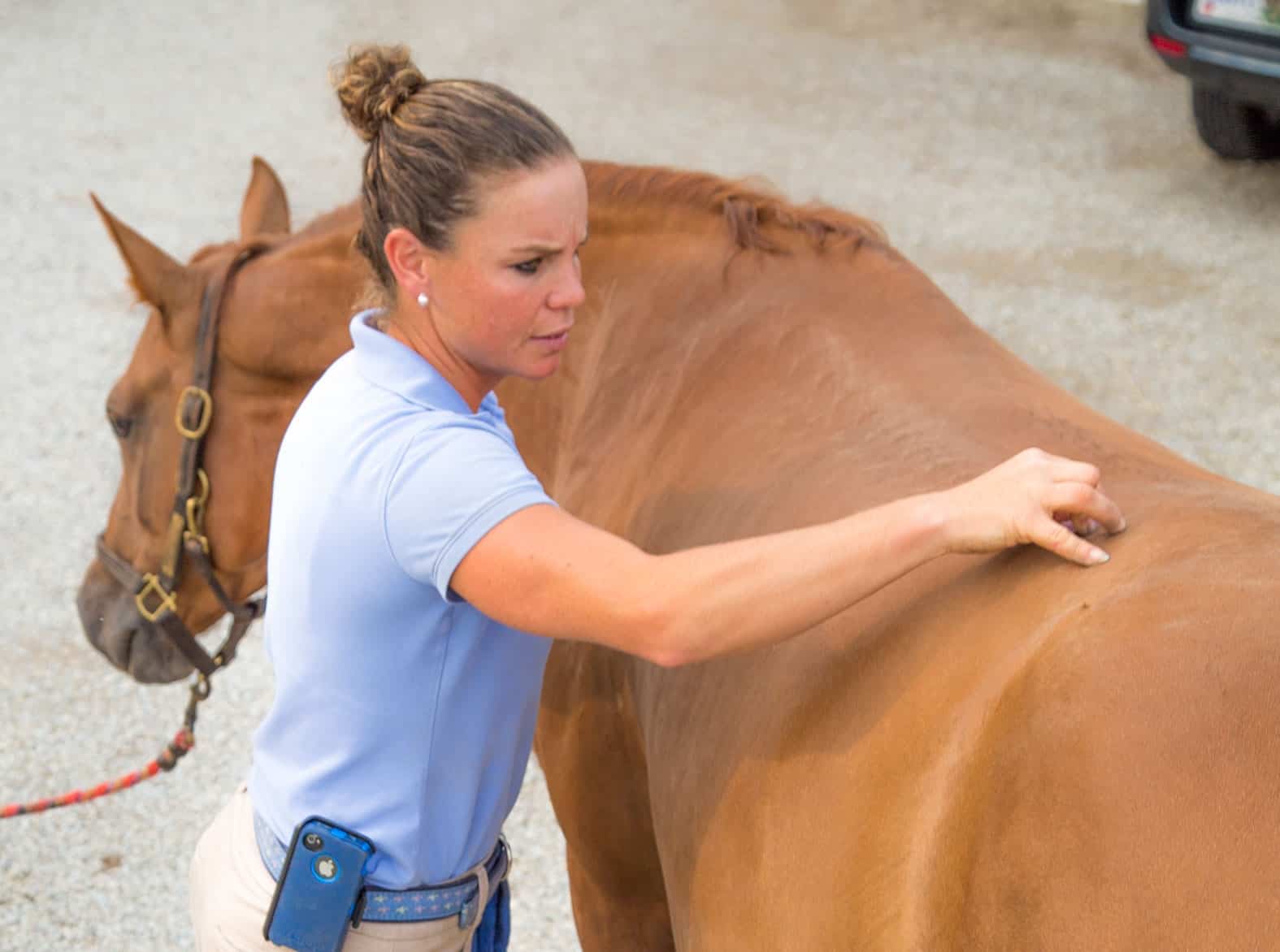Problems in the Horse’s Hip and Pelvis

When you think about equine lameness, you probably think first about the bones, muscles, tendons, and ligaments of the leg, and of course the hoof. But lameness can also stem from trouble higher up the skeleton, including the pelvic (or sacroiliac) region. While considered relatively uncommon, pelvis-based lameness might be more prevalent than previously thought. What’s more, a new strategy combining diagnostic tools with traditional treatment modalities shows promise in improved recovery from some pelvic problems. Here, we’ll give you an overview of problems in the horse’s pelvic region and what can be done about them.
How Common Is It?
In the past, “I believe this (has been) an under-diagnosed area, at least in sport horses,” says Thomas Daniel Jr., DVM, a practitioner at Southern Pines Equine Associates, in North Carolina. As practitioners have gotten access to better imaging and learned more about diagnostics, however, the prevalence of these problems has increased.
“Already at our practice, we’re finding quite a bit of sacroiliac ligament desmitis (ligament inflammation) and sacroiliac joint disease,” he said.
Julia Tomlinson, BVSc, MS, PhD, Dipl. ACVS, CCRP, CVSMT, who spent years studying and working on horses before opening a small animal practice, Twin Cities Animal Rehabilitation and Sports Medicine, in Burnsville, Minnesota, notes that people have often simply overlooked the pelvic area for answers to lameness questions. “They have attributed (problems) to hocks or some miscellaneous muscle (issues),” she says. “Now, more people are looking in that area.”
This increased attention combined with the improved diagnostic techniques we’ll discuss shortly have caused almost a tidal wave of pelvic-lameness diagnoses, says Tomlinson. In general, she adds, “Hock problems are still more prevalent, and you need to rule out problems lower down the horse’s limbs before jumping on the bandwagon of pelvis trouble.”
What To Watch For
Signs of pelvic problems can be quite subtle in the early stages, but the more time passes without treatment, the more noticeable your horse’s discomfort will become, says Thomas Daniel Jr., DVM, a practitioner at Southern Pines Equine Associates, in North Carolina. “Your horse will talk to you—and then your horse will start screaming at you,” he says. Pay close attention and consult your veterinarian if you see any of the following clues to potential pelvic trouble:
- Sudden hindlimb lameness or pain over the back, hip, or croup;
- Intermittent hindlimb lameness;
- Horse might drag the toes of one or both hind hooves;
- Muscle atrophy in the gluteal or lumbar regions;
- Prominent tuber sacrale at the highest point of the rump; combined with muscle atrophy (the “hunter’s bump”);
- Muscle spasms in the lumbar and/or sacroiliac region;
- Asymmetry of the croup;
- Atypical stance (i.e., horse stands with stifle turned out, hock turned in) and/or abnormal head/neck position;
- Performance issues (i.e., resistance to collection, transitions, jumping, or other movements the horse normally performs).
—Sushil Dulai Wenholz
Who’s At Risk?
Since pelvic injuries often result from trauma, they can affect any horse of any breed, gender, age, or discipline. That said, certain groups are at higher risk. These include foals and other young horses not fully trained which might be more susceptible to falls and other trauma during the training process, says lameness and surgery specialist Robin Dabareiner, DVM, PhD, Dipl. ACVS, who’s based in Caldwell, Texas.
Also at higher risk are performance horses at the upper levels of their sport, particularly in high-stress disciplines such as jumping, dressage, reining, and cutting. Besides having jobs that make them vulnerable to such traumas as twists, sprains, hyperextensions, and falls (which can cause fractures and dislocations), these horses place a higher degree of wear and tear on their entire musculoskeletal systems. That makes them more susceptible to ligament injuries and degenerative joint disease throughout their bodies, including the pelvic region, says Daniel.
A Diagnostic Revolution
In recent years, diagnostics has been perhaps the most exciting area of research and discovery related to equine pelvic lameness. Traditionally, when a lameness exam (including such things as limb flexion tests, sacroiliac joint blocks, and rectal palpations to assess sacroiliac motion) has indicated the possibility of pelvic trouble, radiography (X ray) was the only tool available to image the area.
Unfortunately, this method posed two major problems in the past. First, the large radiograph machines required for imaging this area are usually available only at major equine hospitals or universities, making it difficult and expensive for the average horse owner to take advantage of them. Perhaps more significant, radiographing the horse’s hip and pelvis required putting the horse under general anesthesia. “And then you run the risk of the horse injuring itself further if it has a rough or violent recovery from the anesthesia,” says Daniel.
More modern X ray machines have made the process easier, but the area is still difficult to radiograph due to the overlying large muscle mass.
A change for the better came when researchers (including Tomlinson, who did her master’s thesis in this area) started experimenting with other diagnostic tools for imaging the hip and pelvis. Ultrasound has proven to be the best alternative to radiographs. Ultrasound machines are relatively affordable for the average equine practitioner, says Tomlinson, thus making ultrasound more accessible to the average horse owner. Ultrasound is useful in identifying bone fractures and arthritis, says Tomlinson. However, she has also used the tool to establish guidelines for assessing normal vs. abnormal ligament size, with the goal of helping practitioners use ultrasound to diagnose pelvic-area ligament injuries.
Nuclear scintigraphy is also showing promise in imaging the equine sacroiliac region, says Dabareiner. With this method, she explains, the veterinarian injects the horse intravenously with a radioactive material. After three hours, the standing, sedated horse is scanned with a gamma camera. Areas of increased radioactive uptake indicate bone remodeling and show up on the scan as “hot spots.”
Top Four Horse Pelvis Problems
While no pelvic disorder is precisely commonplace, when they do occur, they are likely to fall into one of the following four categories:
Pelvic Fracture
- Results from trauma;
- Most prevalent in young horses (foals to approximately 2-year-olds);
- Might involve nearly any section of the pelvic region;
- Treatment is extended rest for nine to 12 months; and
- Prognosis depends on the placement of the fracture.
Pelvic Dislocation
- The sacroiliac joint might be luxated (displaced or dislocated) or subluxated (partially displaced);
- Usually results from trauma that ruptures a ligament or the joint capsule itself, but can occur from repeated motion that stresses the joint and surrounding support structures (muscles, ligaments);
- Relocation can be attempted under general anesthesia, but prognosis is poor.
Sacroiliac Ligament Strain
- Strain or damage to the ligaments supporting the sacral region;
- Can result from trauma, but often results from repeated stresses to the area;
- Good prognosis with early diagnosis and sufficient rest (six to nine months).
Sacroiliac Osteoarthritis
- Degenerative joint disease might be secondary to trauma or could result from repeated stresses or a systemic infection;
- Prognosis depends on level of degeneration and thoroughness of rest and rehabilitation program;
- Steroid joint injections and pain management can assist with recovery and ongoing maintenance.
Keys to Recovery
Treatment for many pelvic lamenesses, including fractures, often involves extended periods of stall rest, says Dabareiner. This could be anywhere from three to eight months, depending on the extent of injury, with six months of rest being about average. Veterinarians also might prescribe pain medication, such as phenylbutazone (Bute) or flunixin meglumine (Banamine). Alternative therapies (such as chiropractic, acupuncture, and/or massage) might sometimes be used cautiously to assist with pain management.
In cases of sacroiliac osteoarthritis, corticosteroid injections can also be administered. This is another area where newer strategies have yielded positive results. As Daniel explains, previous methods of injecting the pelvis joint might not actually have reached the joint itself, instead sending steroids into surrounding tissue. The mass of flesh normally covering the sacral joint made it difficult to say for sure where the needle ended up. Today, however, veterinarians can perform ultrasound-guided injections to ensure accurate delivery.
Conditioning is another key treatment component, particularly in cases of sacroiliac ligament and muscle damage. As Tomlinson says, “We put (the horse) through the same kind of program as you would with a bowed tendon—rest and then controlled exercise.” The exercise program, adds Daniel, “teaches the horse to utilize (the lumbar) muscles in a more appropriate manner to stabilize and support the pelvic region.” It’s a lot like helping a human build and learn to use their core body muscles, notes Tomlinson.
Collection is painful for horses suffering from pelvic disorders. So the exercise program that Tomlinson uses, and which serves as a guideline for the Southern Pines practitioners, encourages the horse to move in a long, low frame that allows him to stretch while engaging his back. “It starts with walking, then moves to walking over poles, still allowing the horse to put his head down,” says Tomlinson. “Then it goes to hill work, then builds up to trotting, still with the long and low profile. Eventually, it’s an hour of exercise, with 30 to 35 minutes of trotting, and five minutes of canter.”
The End Game
Prognosis for recovery from pelvic injuries depends on multiple factors, including the severity of the problem, how long it goes untreated, and how dedicated the owner is to a complete rehabilitation program. A horse with advanced degeneration of the sacral joint has a grimmer prognosis than one in the early stages of the disease. A horse which has suffered significant muscle atrophy due to prolonged use while injured, or due to repeated, untreated injury of the sacroiliac ligaments, is going to need more recovery time than a horse which just strained a ligament last week and has already started a rest and rehab program.
There are also concerns over secondary issues surfacing as a result of the original disorder. For instance, says Dabareiner, “If a fracture extends into the joint, the horse may develop secondary osteoarthritis in the hip joint.” And a horse which has developed scar tissue while healing from a sacroiliac ligament injury might be prone to re-injury due to the inelastic nature of the scar tissue.
Still, says Tomlinson, “In most cases, we have had very good response with exercise and joint injections once or twice a year. Horses can probably perform at all but the highest levels with this problem. The improved diagnostics are helping us see more of these success stories. The more specific we can get with identifying the problem, the more specific we can be with our treatments–then we can generally give a better prognosis.”
Take-Home Message
Perhaps the key take-home message, says Tomlinson, is that pelvic lameness might sound scary, but it doesn’t necessarily mean the end of the road for your horse. “There are things you can do,” she says. “It may take time, but it’s worth it to get the end result”—a horse which is feeling good and ready to get back to work.
Written by:
Sushil Dulai Wenholz
Related Articles
Stay on top of the most recent Horse Health news with















